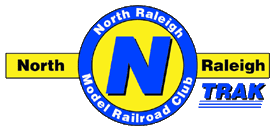This page has moved permanently. If you are not redirected automatically, follow the link to https://nrmrc.org/newsletter/articles/prototype-oriented-articles
![]()
 |
North Raleigh Model Railroad ClubArticles from TRAKing Ahead |
![]()
This page contains selected articles from TRAKing Ahead, the Club's Newsletter, that relate to prototype railroading. Check through the topics; you may find something of particular interest for you! The topics include stories of rail travel by members of the Club. |
According to the current brochure of the New Hope Valley Railroad at Bonsal, NC, for a monetary donation you can operate a locomotive for 1 hour on their main track on a non-operating Sunday. Advance reservation is required - call (919) 362-5416 and leave your name and an after 5:00pm phone number on their answer machine. |
On Sept. 12, 1996 Rocky Mountaineer Railtours dispatched a 34-car train, carrying more than 1,100 passengers, from Vancouver to Jasper and Calgary. Three locomotives pulled 25 Signature Class cars (daynighter coaches), one bilevel Goldleaf Class car, one Silverleaf Class car, three power cars, three baggage cars and one lounge-smoking car.
|
For anyone who has traveled to Churchill, the Canadian province of Manitoba's grain shipping port on Hudson Bay (that's far north and cold), memories will include the picture of miles of railway sidings crowded with boxcars, their uniqueness ensured by the figure of a buffalo painted on the side with the designation "Manitoba." These were the so-called "Buffalo" 40' boxcars dedicated by the province and Canadian National to the movement of grain from prairie farms to the salt-water port.
Muskeg: n. a sphagnum bog of northern North America
|
By Bruce Faulkner Hamlet, North Carolina is a small town about 2 hours south of Raleigh. Hamlet came to be known as the Hub of the Seaboard in reference to its location at the convergence of 5 different Seaboard Air Line routes: one line went north to Raleigh and Richmond; another went south to Columbia, Savannah and Jacksonville; a 3rd went west to Monroe, NC; a 4th went east to Wilmington, NC; and the 5th went southeast to Andrews and Charleston, SC. While CSX Transportation has taken over and downgraded 2 of those routes, Hamlet is still very much a busy hub for CSX operations in the Carolinas.
|
by Chuck Dopler On a recent April Friday afternoon, I took a road trip to Hamlet to soak in a little sun and diesel fumes. It was a gorgeous day and the rails were singing to me as they do..."Oh Chuuuck! Come on..." Well, you know that song. There's something either new to spot, or something old that's about gone for good. And this trip reminded me of that especially well.
|
Union Pacific's 4-8-4 steam locomotive #844, Class FEF-3, is the only steam locomotive in existence today that has never been retired from active service. It was the last of 45 locomotives built by Alco for the Union Pacific between 1937 and 1944 to power passenger and fast freight trains, and was the last steam locomotive delivered to the Union Pacific.
|
A major "cargo" for the railroads used to be the shipping of cattle and other livestock, but that ended mostly in the 60's and 70's as trucking took over. Until recently the Union Pacific continued to haul livestock. But hauling cattle and livestock could prove an interesting industry on your railroad if the time period is right.
The HOGX 50 footers were originally built by Gunderson Rail Cars in Portland, OR as auto parts cars for the Missouri Pacific, and were later rebuilt for the HOGX trains.
|
Copyright © 1996–2009 North Raleigh Model Railroad Club. All rights reserved.
|
North Raleigh Model Railroad Club |